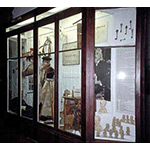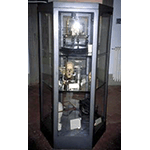Museo di Storia Naturale di Firenze - Sezione di Antropologia ed Etnologia [Florence Museum of Natural History - Anthopology Section]
Planned and founded by Paolo Mantegazza in 1869 to document the evolution of mankind and the development of civilisation, the Museum of Anthropology and Ethnology was the first university anthropological museum in Europe. At the beginning, the collections of the Museum of Physics and Natural History were transferred here. In the same year of the Museum's foundation, the first Italian Chair of Anthropology was established at the Florence Institute of Higher Studies. It was directed by Mantegazza who, in 1871, founded the "Italian Society of Anthropology and Ethnology" and instituted a specialised library, today one of the world's most important. The Society significantly contributed to the development of anthropology as a science with a status of its own. Before this, in fact, anthropology had been studied as a branch of philosophy and the natural sciences. Again in 1871, the Archive for Anthropology and Ethnology, the official organ of the Florentine Society, was founded. In 1878 the Society changed its name to "Societą Italiana di Antropologia, Etnologia e Psicologia Comparata", to emphasize its intention of conducting an integral study of mankind. After 1910 it was decided to return to the original name, since by now psychology was engaging in specific research conducted by methods of its own.
In 1901, on the occasion of the thirtieth year of the Society of Anthropology and Ethnology, an Anthropometry Laboratory was set up to study human forms by measuring the body in all of its parts; these studies continued over the following years. The Museum possesses some historic anthropometric instruments (50 objects) constructed in the late 19th century and the first half of the 20th: compasses for taking measurements of living beings, which have rounded points to avoid injuring the skin, compasses for osteological measurements, which instead have sharp points, pendulum goniometers for determining facial angles, and anthropometers for calculating the various heights. The data obtained from the measurements were then used for statistical purposes.
In 1915 the collections of the Indian Museum were incorporated; founded by Angelo De Gubernatis, it consisted of numerous objects collected by him during a voyage to India undertaken between 1885 and 1886.
At present the Museum possesses important collections. The anthropological collection, begun by Mantegazza at the time when the Museum was founded, includes human skeletal remains from recent and ancient times (the Neolithic, Aeneolithic, the Bronze and Iron Ages, as well as Etruscan remains and those of the Roman and Barbarian ages); soft parts (anatomical specimens); a trichology collection; a plaster casts gallery; portrait busts and masks taken mainly from living human beings belonging to groups from various parts of the world. The ethnological collection, whose original core consists of objects coming from the Medicean collections, is of mainly non-European origin. Of particular scientific interest are the collections of the Laplanders and the Samoyeds, of Papuasia and ancient Peru. From the time of the Museum's foundation to today, its collections have been constantly incremented. It also has an important collection of photographic material with negatives and positives of mainly anthropological subjects, often displayed in their own cultural contexts. The latter collection, formed by Mantegazza, who also founded the Italian Photographic Society, acknowledges the value of photography as scientific recording. The collection includes numerous photographs of voyages.
The Museum first occupied premises in Via Ricasoli, then in Via Capponi and lastly, since 1924, its current seat, the historic Palazzo Nonfinito in Via del Proconsolo.
****************************
Texts by Graziano Magrini
English translation by Catherine Frost
Last update 04/gen/2008





